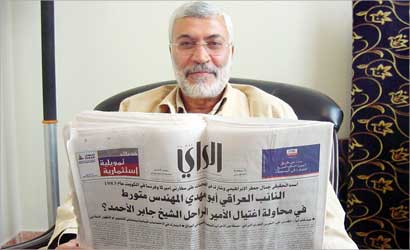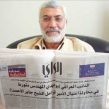
Kata’ib Hezbollah and the Intricate Web of Iranian Military Involvement in Iraq
Publication: Terrorism Monitor Volume: 8 Issue: 9
By:

It is no secret that Iran’s influence runs deep in Iraq. Most Iraqi politicians with close ties to Iran, however, are wary of tarnishing their nationalist credentials by admitting that they prefer to cooperate with Iran rather than the United States, in part because of growing anti-Iranian sentiment in Iraq.
Beginning in late 2006, the leaders of the Sunni Awakening Movement openly aligned themselves with the U.S. military in an eventually successful campaign against terrorist groups in their midst. With a few notable exceptions, Iraqis who have aligned themselves with Iran against the U.S. in Iraq seek to keep their ties with Iran hidden.
While Iran’s influence comes in a variety of forms, its covert support for armed militias in Iraq is the source of much speculation. The United States has cited financing, training, and arming of Shi’a militant groups as elements of Iran’s “nefarious” conduct in Iraq (Congressional Research Service, June 4, 2009).
Iran’s military assistance to armed groups outside of Iran is run by its Quds Force, a branch of the Islamic Revolutionary Guard Corps (IRGC). The IRGC was established to defend the Islamic Revolution and cut its teeth during the Iran-Iraq War, fighting Iraqi forces on the frontlines and backing “fifth columns” throughout the region. The Quds Force was also tasked with propagating the Islamic Revolution beyond Iran’s borders. Its most notable success to date has been Lebanon’s Hezbollah. The Quds Force supported and trained anti-Saddam Iraqi militias, including those associated with Iraq’s main Shi’a political parties now holding power in Iraq. These now-mainstream Shi’a political parties disbanded their militias or integrated them into the Iraqi security forces in order to participate in the U.S.-sponsored political process, but the Quds Force has continued to support new armed militias in Iraq. The role of these militias has been described in the West as the “tip of Iran’s spear.”
The commander in charge of the Quds Force is Brigadier General Qassem Suleimani. Little is known about Suleimani, but his influence in Iraq became visibly clear when he brokered an end to the fighting between Muqtada al-Sadr’s Jaish al-Mahdi and Iraqi security forces in March 2008 (McClatchy, April 28, 2008). Sadr was the last of Iraq’s leading Shi’a leaders to ostensibly disband his party’s militia, which was established only months after the U.S. invasion, unlike other Shi’a militias that had been nurtured in Iran by the Quds Force during Saddam’s reign.
Kata’ib Hezbollah (Brigades of the Party of God) is one Baghdad-based Shi’a militant group that has been accused of being a surrogate of Iran’s Quds Force in Iraq. While not the most powerful or the best known, the group is described by the United States as an Iran-backed militant group that actively smuggles and stockpiles Iranian-made weapons in Iraq.
On February 12, U.S. and Iraqi security forces led a mission targeting Kata’ib Hezbollah in Iraq’s Maysan province. The joint raid took place in rural villages near the Iranian border. At least five people were reportedly killed and some 22 suspected members of the group were arrested. Following the raid, the U.S. military said that there had been “a recent increase in lethal aid smuggling facilitated by members of Kata’ib Hezbollah, who then stockpile weapons and explosives in Iraqi communities for future attacks” (United States Forces – Iraq, Press Release USF-1, February 12).
Between March 2007 and June 2008, Kata’ib Hezbollah led a number of attacks against U.S. forces in Iraq (U.S. Treasury Department, Press Release TG-195, July 2, 2009). Throughout 2008, Al-Manar, Hezbollah’s television outlet in Lebanon, played numerous videos of Kata’ib Hezbollah launching rocket and roadside bomb attacks against U.S. troops. This helped put Kata’ib Hezbollah on the map among leading Shi’a militant groups. In December 2009, it was reported that the group had successfully hacked into U.S. Predator drone video feeds, presumably enabling its members to monitor and evade U.S. military operations (Army Times, December 21, 2009).
While the leadership of Kata’ib Hezbollah remains murky, one individual reportedly associated with the group is an Iraqi by the name of Jamal Ja’far Muhammad, but well-known in Iraq as Abu Mahdi al-Muhandis (a.k.a. The Engineer). He has been described as the “right-hand man” of Qassem Suleimani, the head of Iran’s Quds Force (Sharqiyah TV, January 2). Al-Muhandis is wanted in Kuwait for his alleged role in the 1983 bombings of the American and French embassies in Kuwait City, as well as for his alleged involvement in the assassination attempt on the Kuwaiti Emir in 1985—both deemed to be Quds Force attempts to deter U.S., French, and Kuwaiti support for Iraq in its war with Iran. The U.S. Treasury Department designated Kata’ib Hezbollah and Abu Mahdi al-Muhandis as threats to the stability of Iraq in July 2009 (U.S. Treasury Department, Press Release TG-195, July 2, 2009).
Despite these allegations, al-Muhandis has been a member of the Iraqi parliament since March 2006 as part of the main Shi’a bloc, the United Iraqi Alliance (Al-Adala, November 8, 2005). He is running again in the March 7 election as part of the Iraqi National Alliance. Despite holding a seat in parliament for the past four years, he does not attend the parliament’s sessions and spends much of his time in Tehran. Prior to 2003, he lived in Iran for about 20 years. In an interview on Iraqi television on January 26, al-Muhandis said that he has come under threats by the United States and has basically decided to wait out the withdrawal of American troops (Al-Sharqiyah TV, January 26). Iraq’s Constitution provides all members of parliament with total immunity, which can only be lifted by the consent of an absolute majority of the parliament.
Muhandis, 56, joined the Da’wa Party in the early 1970s and left Iraq for Kuwait later that decade, working in Kuwait City as an engineer. Following the 1983 bombings, he fled Kuwait for Iran. He joined SCIRI in 1985 and became a senior leader in its Badr Brigade, which fought against Saddam during the Iran-Iraq War under the guidance of the IRGC (Al-Sharqiyah TV, January 26).
Abu Mahdi al-Muhandis is not the only Iraqi political figure to align himself so closely with Iran’s Quds Force, but he is one of few who openly admits it. His ability to maintain one hand in Iraq’s parliament and another in Iran’s Quds Force and its involvement with Shi’a militant groups such as Kata’ib Hezbollah is a clear manifestation of the intricate and tangled web of Iraq-Iran relations.





